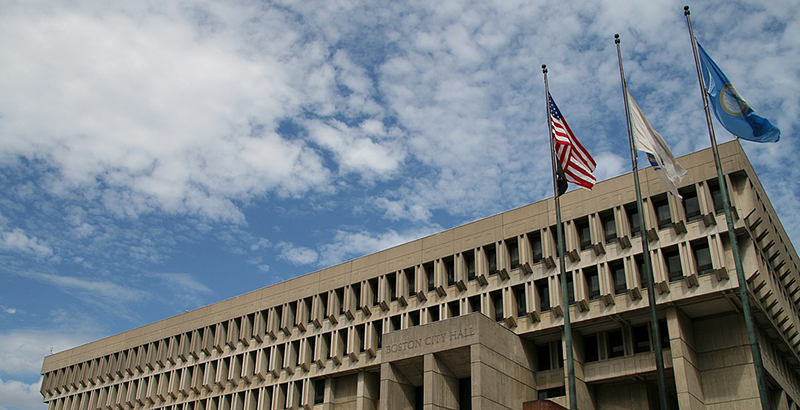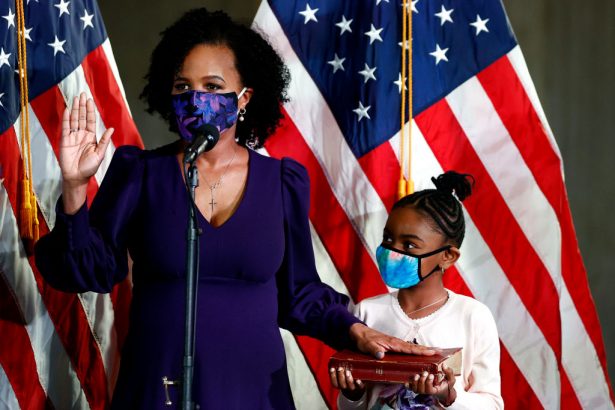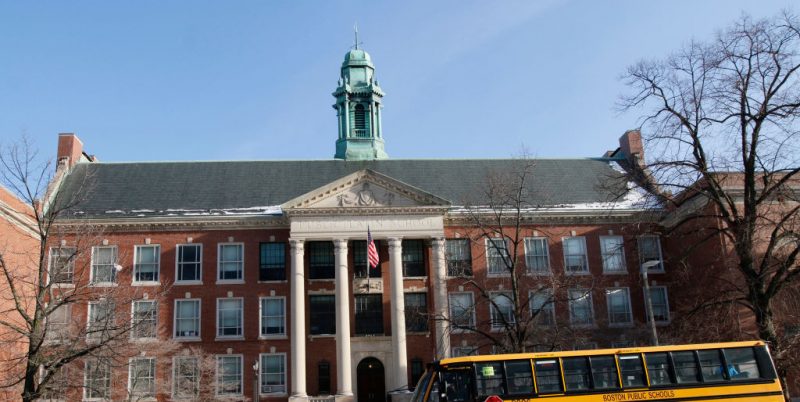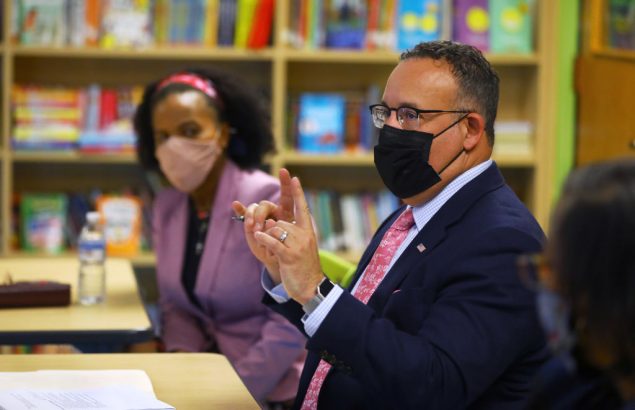Boston’s Next Mayor Will Inherit Schools Beset by Poor Performance and Admissions Controversies — and That Was Before COVID

Get stories like these delivered straight to your inbox. Sign up for The 74 Newsletter
Updated September 16
In Boston’s mayoral primary, city councilors Michelle Wu and Annissa Essaibi George were the top two finishers, respectively winning 33.3 percent and 22.5 percent of the vote. Acting Mayor Kim Janey, the first woman and first African American to serve as the city’s mayor, finished in fourth place. Wu and Essaibi George will proceed to the general election November 2.
On September 9, public schools in Boston will open for the 2021-22 academic year — the first since last March, locals hope, not to be irreversibly damaged by the COVID-19 pandemic. Five days later, the city will hold the first round of a two-step election process to decide its next mayor, whose time in office may come to be defined by the performance of a school district that has struggled in recent years.
Those two deadlines are clearly connected in the minds of the electorate. According to a June poll conducted by Suffolk University and the Boston Globe, schools were rated the most important issue by about 18 percent of likely voters across the city, ahead of the economy, crime, and police reform and practically identical to the top-ranking items of housing (20 percent) and racial justice (19 percent). In areas of the city that have historically posted some of the highest levels of voter turnout, K-12 was ranked the most important issue by far.
David Paleologos, director of the Suffolk University Political Research Center, observed that the public is drawing connections between the disparate K-12 issues, from police officers in schools to COVID remediation, in a way that could make education “the issue of the year.”
“You’ve got a constant thread where people are recognizing how important education is, and I think you’re going to see it continue to bubble up through the school reopening and even beyond,” Paleologos said.
Seven candidates have emerged to replace former Mayor Marty Walsh, who was appointed U.S. Secretary of Labor in March. That group, which will be winnowed to two finalists after the preliminary election on September 14, is striking for its representative diversity. Among the favorites to compete in November are three city councillors who would each be the first woman and first person of color elected to lead Boston. (A fourth, Acting Mayor Kim Janey, already set both precedents when she was elevated to the position this spring and is seeking her first elected term).

Whoever wins will face the significant challenge of turning around schools in the birthplace of American public education. Boston Public Schools, once considered something of an exemplar among major urban districts, was widely seen as regressing even before the emergence of the coronavirus. While local experts generally acknowledge the need for improvement, much of the public’s attention has been directed at an acrimonious debate over the admissions practices of the city’s three competitive-admissions schools. But the comprehensive improvements needed to lift the performance of the rest of the system, and arrest its persistent decline in enrollment, haven’t led the discussion.
Most of the bandwidth among parents is also consumed by concerns about the pandemic, says Paul Reville, Massachusetts’s former education secretary. The increased salience of K-12 schools measured in the Suffolk poll results from a desperate desire to return to the pre-COVID state of existence, when families, schools, and employers could take the school day for granted, he said; but the next mayor will need to accomplish a great deal more than negotiating a return to the status quo ante.
“We’re not debating strategy so much right now as we’re debating survival issues,” Reville said. “Are we going to open or not? Will we have enough room for all the students? Will they have to wear masks? What happens if the current spike in numbers keeps going? It’s hard to concentrate on the strategic when the day-to-day is so challenging.”
Critical audit
March 13, 2020, was the most significant day in the recent history of Boston Public Schools. That Friday, then-Mayor Walsh and Boston schools Superintendent Brenda Cassellius announced that the district would close all buildings to in-person learning for six weeks. In fact, the initial reopening date would come and go, with most students stuck at home for the better part of a year.
But another crucial development had been announced just hours earlier, when local officials signalled that the district would be entering a unique governing partnership with the state of Massachusetts to improve learning outcomes for students. The announcement followed the release of a harsh audit of Boston’s academic performance, which found that one-third of its students attended schools ranking in the bottom 10 percent statewide. State authorities would provide support to the system going forward, but also hold it responsible for meeting specific performance goals.
The new arrangement was especially startling given Boston’s reputation as a comparatively high-flying district among its large, urban peers. Beginning in the 1990s and early 2000s, national observers began to celebrate the steady growth in student test scores, which was widely attributed to then-Superintendent Tom Payzant’s efforts to restructure curricula and focus on literacy instruction. While large gaps still separated the city’s underprivileged children from their peers in nearby suburbs, the arrow was definitively pointing upwards.
The progress began to slow about a decade ago, according to a report by the research organization Bellwether Education Partners, as the district cycled rapidly through a sequence of short-lived and interim superintendents before landing on Cassellius in 2019. The 2020 “memorandum of understanding” — which created a substantial role for state oversight while stopping short of a takeover — might have offered an opportunity to reclaim momentum. But according to John Portz, a political scientist at Northeastern University, it was instantaneously overshadowed by COVID.
“That would have been a key jumping-off point, if you will, for where education was going to go,” Portz said. “But it just got totally swallowed up by the pandemic. Thinking back, no one has talked about it, and I wonder whether it’s simply a dead letter at this point.”
Exam school admissions
The prolonged closure of the city’s 125 schools pushed systemic recovery far down the agenda, with a proposed “redesign” of local high schools faltering as Walsh and Cassellius attempted to chart a course to safe reopening. The process became bitterly political at times, as when the Boston Teachers Union passed an overwhelming vote of no confidence in Cassellius last December, citing unequal access to ventilation, testing, and protective gear.
Once K-8 schools returned, attention shifted again to the city’s public “exam schools”; of the three, the best known is Boston Latin, whose lofty alumni roll extends from Ben Franklin and John Hancock to many present-day elites in media, politics, and business. A decades-old debate over the school’s rigorous admissions test was first reignited in 2017, when a report found that just one-quarter of Latin’s students were African American or Hispanic — compared with roughly three-quarters of Boston students overall.
Hearings held on the subject last fall by the Boston School Committee — a seven-member body appointed by the mayor — quickly became heated, with many parents arguing in favor of the existing admissions requirements and others calling for the introduction of criteria that might increase the odds of disadvantaged students winning seats. The debate grew so charged that three members later resigned after it was discovered that they had mocked and insulted Asian American parents and those living in the predominantly white neighborhood of West Roxbury. Still, the committee voted unanimously in July to approve a new admissions system that will decrease the importance of exam scores relative to school grades and reserve more seats for students living in low-income areas of Boston.

The controversy has attracted enormous coverage in local media. The changes are supported by three leading candidates in the September preliminary, including Acting Mayor Janey, Councilor Michelle Wu, and Councilor Andrea Campbell. Only Annissa Essaibi George, another city council member who previously worked as a teacher in East Boston, criticized the new system and the process that led to its adoption.
That position may position her favorably with families living in the largely middle-class West Roxbury and Hyde Park neighborhoods, who typically make up as much of a quarter of the city’s electorate. Attorney Larry DiCara, a former city councillor and longtime observer of city politics, said that the issue’s outsized importance could swing more votes than one might expect.
“In some neighborhoods, the Latin issue is the most important issue,” DiCara said. “There are parents who, if their kids don’t get into Latin, they move.”
But Will Austin, a former teacher who founded the nonprofit Boston Schools Fund, said he was dismayed by the race’s persistent focus on what he called “click-bait-y” issues at the expense of a more substantive conversation of the district’s stagnant academic results.
“You can’t lead systematic reform by changing which kids go to three of your 125 schools, which is essentially what we spent a couple of months doing,” Austin argued.
No ‘education candidate’?
There is still little clarity on which two candidates will advance in the preliminary election round. The most recent polls, conducted in late August and early September, put Wu in the lead, with Janey, Essaibi George, and several lower-ranked candidates further behind. But around one-fifth of respondents were undecided, and any configuration of the top-four candidates is generally viewed as plausible.
All four can broadly be defined as progressive, with Essaibi George venturing somewhat toward the center in her attitudes on exam schools and public safety. But Northeastern’s Portz said that the lack of more ideological differentiation made it difficult for the candidates to build more distinct brands.
“It’s tough to some degree because they’re driven by events in the news, the exam schools or the school committee resignations,” he said. “Those things are capturing more attention, and it’s hard for them to strike out and distinguish themselves.”

The race is notably different in this respect from the recent primary held in New York City, in which leading candidates sorted into camps of progressives and moderates. The moderates — including the eventual Democratic nominee, Eric Adams — generally supported the city’s charter school sector and advocated for more modest changes to admissions criteria for the city’s own exam schools.
DiCara served on the city council in the 1970s, when the district still enrolled over 100,000 students and a robust network of parochial schools served tens of thousands more. In a 2015 paper, he argued that runaway housing costs had made Boston less friendly to families and the working class, while the disappearance of children rendered public education a less relevant concern to the city’s newer, more affluent residents.
“The dramatic changes to the population, where we have so many single people in Boston or married people without children, make Boston very different from New York City,” DiCara said. “Once you get out of Manhattan, [New York is] really a city with a lot of families.”
The city’s thought leaders have taken note of the short shrift given to schools during the campaign, with an August op-ed in the Boston Globe wondering aloud why no “education candidate” had yet emerged. Wu and Essaibi-George (a former BPS teacher) have each released lengthy proposals concerning education and childcare; Janey, the acting mayor, can even boast of a long career as an advocate for children and families. But so far, none of it has produced a sustained conversation about what it would take to put Boston schools on the road to improvement.
Austin said that Boston municipal races are often dominated less by policy debates than personal experience.
“Every candidate in Boston is going to talk about how housing is unaffordable. Every single candidate will talk about how we need to reform the police. Every one will say that racial equity is core to their work. They don’t have really significant policy differences, so they differentiate themselves through how they campaign and their biographies.”
Reville said that the lack of greater variation within the field has held back the kind of boundary-breaking proposals that would address the key issue plaguing education in Boston: “too many longstanding, ongoing, chronically underperforming schools.”
“Nobody’s coming along to propose radical change,” he said. “You’re not hearing someone saying, for instance, ‘Let’s make summer learning an entitlement for every child in the Boston Public Schools.’ Or, ‘Should we be doing something radically different, given the changing population within the Boston Public Schools?’ We don’t have a lot of outlier proposals to make a radical shift in the status quo. It’s hard to change, and there’s an enormous amount of inertia.”
Get stories like these delivered straight to your inbox. Sign up for The 74 Newsletter

;)
